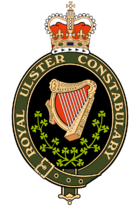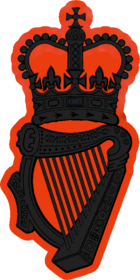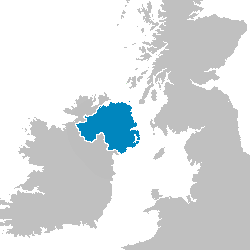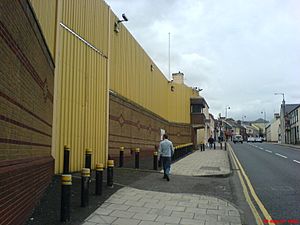Royal Ulster Constabulary facts for kids
Quick facts for kids Royal Ulster Constabulary |
|
|---|---|

Badge of the RUC
|
|

Cap Badge of the RUC from 1970 onwards.
|
|

Flag of the RUC
|
|
| Abbreviation | RUC |
| Agency overview | |
| Formed | 1 June 1922 |
| Preceding agency | |
| Dissolved | 4 November 2001 |
| Superseding agency | Police Service of Northern Ireland |
| Legal personality | Police force |
| Jurisdictional structure | |
| National agency | Northern Ireland |
| Operations jurisdiction | Northern Ireland |
 |
|
| Map of Royal Ulster Constabulary's jurisdiction | |
| Size | 14,130 km2 (5,460 sq mi) |
| General nature | |
The Royal Ulster Constabulary (RUC) was the main police force in Northern Ireland from 1922 to 2001. It was created on June 1, 1922. The RUC took over from the Royal Irish Constabulary (RIC) after Ireland was divided. At its busiest, the RUC had about 8,500 police officers. There were also 4,500 members in the RUC Reserve.
The RUC policed Northern Ireland for many years. They played a big part during a difficult time called the Troubles. This period lasted from the 1960s to the 1990s. Because of threats from groups like the Provisional Irish Republican Army (IRA), the RUC was heavily armed. Officers often carried submachine guns and assault rifles. They traveled in armored vehicles and worked from strong police stations. The RUC was also the first police force to use rubber and plastic bullets to control crowds.
Most RUC officers were Protestant. This led to some Catholic and Irish nationalist people saying the policing was unfair. They also accused officers of police brutality. However, British security forces praised the RUC as a very professional police force. During the Troubles, 319 RUC officers were killed. Almost 9,000 were hurt in attacks, mostly by the IRA. By 1983, the RUC was considered the most dangerous police force in the world to serve in. In 2000, the RUC received the George Cross for their bravery.
The RUC was replaced by the Police Service of Northern Ireland (PSNI) in 2001. This change happened because of a law called the Police (Northern Ireland) Act 2000.
Contents
History of the RUC
How the RUC Started
After the Government of Ireland Act 1920, Northern Ireland was under the Royal Irish Constabulary (RIC). In 1921, a committee was set up to plan a new police force. This committee advised on how to create the new force.
The new Parliament of Northern Ireland accepted the plan in 1922. On April 29, 1922, King George V named the force the Royal Ulster Constabulary (RUC). The RUC officially began on June 1, 1922. Its main office was in Belfast. The uniform was dark green, similar to the RIC.
From the start, the RUC had two main jobs. They provided normal law enforcement services. They also worked to keep Northern Ireland secure. To do this, their members carried weapons. The RUC was planned to have 3,000 officers. At first, one-third of the jobs were for Catholics. This was to match the population of Northern Ireland. Many former RIC members who were Catholic joined. However, the number of Catholics in the RUC never went above 20%. By the 1960s, it had dropped to 12%.
The RUC was supported by the Ulster Special Constabulary. This was a group of part-time volunteer police. The RUC's top officer, the Inspector General, was in charge of keeping law and order.
Early Years of Policing
The political situation in Northern Ireland in the 1920s was very tense. There was violence from both sides. A police report from 1923 described the problems in Belfast. It said that the IRA caused many murders and bombings. But Protestant groups also caused trouble. This made it hard for the police to control the situation.
About 90 police officers were killed between 1920 and 1922. This was during what is known as The Troubles in Northern Ireland (1920–1922). By the mid-1920s, things became calmer. For the next 45 years, Northern Ireland had less crime than the rest of the UK.
The 1920s and 1930s were tough economic times. Many industries struggled, leading to high unemployment. In 1932, there were riots in Belfast over unemployment relief. The RUC also created a Traffic Branch in 1930. A new police training center opened in Enniskillen in 1936. The Criminal Investigation Department (CID) in Belfast also grew.
There was some IRA activity in the 1930s. In 1937, the IRA bombed customs posts during a royal visit. During the Second World War, the RUC had new duties. They had to secure the border with neutral Republic of Ireland. They also enforced wartime rules like "black-out" requirements.
The RUC was considered an "essential job" during the war. Its members could not leave to join other military services. In 1943, women were finally allowed to join the RUC. The first six women started on November 15. After the war, conditions for the RUC improved. There was some IRA activity again from 1957 to 1962. Seven RUC officers were killed during this time. In the 1960s, the force was updated. A new headquarters opened in Belfast.
The Troubles Begin

The civil rights protests in the 1960s led to the start of "the Troubles". The RUC faced marchers protesting against unfair voting districts and housing. Many of these protests were stopped by the government. The Ulster Special Constabulary (B-Specials) were seen by some as unfair to Catholics. Because of the pressure on the RUC, the British Army was called in to help in August 1969.
Changes and Reforms
The unrest led to a big study of policing by Lord Scarman in 1972. In 1969, James Callaghan, a government minister, asked Brigadier John Hunt to review the police. The Hunt Report was published on October 3, 1969. Most of its ideas were put into action. The goal was to completely change the RUC. This meant making it more like other UK police forces.
The changes included new police ranks and divisions. The Ulster Special Constabulary was disbanded. A new Police Authority was created to represent everyone. Sir Arthur Young was brought in to help with these changes. The RUC Reserve was formed as a support police force. Military duties were given to the new Ulster Defence Regiment.
First Deaths in the Conflict
The first deaths of the Troubles happened in July 1969. Francis McCloskey, a 67-year-old Catholic man, died after a police baton charge. Witnesses said police hit him. Police said he was already unconscious.
On October 11, 1969, Constable Victor Arbuckle was shot and killed by loyalists. This happened during riots in Belfast. He was the first police officer killed in the Troubles. In August 1970, two young constables, Donaldson and Millar, died when a car exploded. They were the first security forces victims of the Provisional Irish Republican Army campaign. This campaign targeted police officers until 1997. The last RUC officer killed, Constable Francis O'Reilly (a Catholic), died in 1998. He was killed by loyalists in a bombing.
Later Years of the RUC
In March 1972, the government of Northern Ireland stepped down. Northern Ireland then came under direct rule from London. From the mid-1970s, RUC officers took a bigger role in the conflict. This led to more RUC officers being hurt or killed.
In the early 1980s, some IRA and INLA members were shot dead by the RUC. This led to accusations that the RUC had a "shoot-to-kill" policy. In 1983, four officers were charged with murder. They were later found not guilty. The British government then started an investigation called the Stalker Inquiry.
In 1986, Chief Constable Sir John Hermon said that unionist politicians were working with paramilitary groups. Anger over the Anglo-Irish Agreement led to loyalist attacks on homes of Catholics and RUC officers. Many RUC families had to move.
In 1998, Chief Constable Ronnie Flanagan said he did not want RUC officers to be members of the Orange Order. The RUC grew in size over the years. At its largest, there were 8,500 regular officers. There were also about 5,000 reserve officers. This made it the second largest police force in the UK. The RUC was led by the Chief Constable.
Policing a Divided Society
Policing Northern Ireland was hard because of the divided society. Protestants and Catholics had different views on the government and police. Most Ulster Protestants saw the government and police as legitimate. Many Catholics, however, believed that Northern Ireland would only be temporary. They often did not take part in the government. This was partly because of how Catholic civilians were treated by the Ulster Special Constabulary.
Protestants worried that Catholics who were not loyal to the new state would join government services. This made society more divided. It also made many Catholics unwilling to join the police or civil service.
In 1922, the Orange Order was allowed to form a lodge within the RUC. In 1924, a District Inspector was fired for making a "fiercely Unionist" speech. A 1936 report said that the government made police hesitant to interfere with the Orange Order.
When the RIC was disbanded in 1922, the RUC was planned to have 2,000 former RIC members and 1,000 "A Specials." It was hoped that half of the RIC recruits would be Catholic. But fewer Catholics joined than expected.
Throughout its history, Catholic leaders often told Catholics not to join the RUC. Seamus Mallon, a Catholic politician, said the RUC was "97% Protestant and 100% unionist." However, some Catholics did join, especially former RIC members. The number of Catholics in the RUC dropped as these men retired.
Some notable Catholic RUC officers included Chief Constable Sir James Flanagan. In 1997, a leaked document showed that one-third of Catholic RUC officers reported facing discrimination from Protestant colleagues.
RUC Casualties
According to one book, 314 RUC officers were killed. Over 9,000 were injured during the RUC's existence. Almost all of these deaths happened during the Troubles (1969 to 1998). Most were killed in attacks by Irish republican groups. The CAIN project says 301 RUC officers and 18 former officers were killed, making a total of 319.
The Newry mortar attack in 1985 killed nine officers. This was the highest number of RUC deaths in one incident. The highest-ranking RUC officers killed were Chief Superintendent Harry Breen and Superintendent Robert Buchanan. They were killed in an ambush by the IRA in 1989. A 2013 report suggested that police in the Republic of Ireland might have helped in their killing. The last RUC officer killed in the conflict was Francis O'Reilly in 1998. He died after a pipe-bomb attack by the Red Hand Defenders.
Criticism of the RUC
Treatment of Children
In 1992, Human Rights Watch (HRW) reported on how children were treated during the Troubles. Both Catholic and Protestant children said RUC officers physically hurt and mentally harassed them. This was often done to force false confessions. HRW said that police and soldiers would hit, kick, and insult young people on the street. They also said that children were held in adult prisons.
The Patten Report
The Good Friday Agreement (GFA) of 1998 brought big changes to policing. Because of concerns about bias and the low number of Catholics in the RUC, a review was done. This review was led by Chris Patten. The report came out in September 1999. It suggested a complete change for policing. The Royal Ulster Constabulary was to be replaced by the Police Service of Northern Ireland (PSNI). The report also pushed for more Catholics to join. The PSNI started in November 2001. As part of this change, the police force dropped "Royal" from its name. It also adopted a new badge.
Collusion with Paramilitaries
Special Patrol Group
The Special Patrol Group was formed in the late 1960s. It was later renamed the "Divisional Mobile Support Unit" in 1980. This happened after two of its members were found guilty of kidnapping and murder. These two officers said that some of their colleagues helped loyalist paramilitaries. They claimed that senior officers knew about these actions.
The Stevens Inquiries
Sir John Stevens led three investigations into collusion. Collusion means secret cooperation between police and paramilitary groups. His third report came out in 2003. Stevens looked closely at the killings of Brian Adam Lambert and Pat Finucane. He defined collusion as things like not keeping good records, not being accountable, holding back information, or officers being involved in murders. In 2012, British Prime Minister David Cameron admitted that "shocking levels of collusion occurred in the murder of Finucane."
Police Ombudsman's Report
In 2007, the Police Ombudsman Dame Nuala O'Loan released a report. It said that Ulster Volunteer Force (UVF) informers committed serious crimes, including murder. Their police handlers knew about these crimes. The report also said that RUC Special Branch officers created false statements. They also blocked evidence searches.
Awards Received
RUC officers received many awards for bravery. These included 16 George Medals and 103 Queen's Gallantry Medals. On April 12, 2000, the RUC was awarded the George Cross for bravery. This is a very rare honor. It had only been given to a whole group once before, to the island of Malta. The award recognized the RUC's bravery during 30 years of terrorism. It noted that 302 officers were killed and thousands injured. Many officers were also shunned by their own communities. The award honored the "collective courage and dedication" of all RUC members.
Chief Officers of the RUC
The top officer of the RUC was first called the Inspector-General. Five officers held this role between 1922 and 1969. The last was Sir Arthur Young. He changed the title to Chief Constable. Six more people held this job until the RUC became the PSNI. The last Chief Constable, Sir Ronnie Flanagan, became the first Chief Constable of the PSNI.
- Inspector-General Sir Charles Wickham, from June 1922.
- Inspector-General Sir Richard Pim, from August 1945.
- Inspector-General Sir Albert Kennedy, from January 1961.
- Inspector-General Sir Anthony Peacocke, from February 1969.
- Inspector-General Sir Arthur Young, from November 1969.
- Chief Constable Sir Graham Shillington, from November 1970.
- Chief Constable Sir James Flanagan, from November 1973.
- Chief Constable Sir Kenneth Newman, from May 1976.
- Chief Constable Sir John Hermon, from January 1980.
- Chief Constable Sir Hugh Annesley, from June 1989.
- Chief Constable Sir Ronnie Flanagan, from October 1996 – November 2001.
Ranks of the RUC
| Ranks 1922-1930 |
||||||||||||
|---|---|---|---|---|---|---|---|---|---|---|---|---|
| Inspector-General | Deputy Inspector-General | County Inspector | District Inspector 1st Class | District Inspector 2nd Class | District Inspector 3rd Class | Head Constable Major | Head Constable | Sergeant | Constable | |||
| (insignia of a Brigadier) | (insignia of a Colonel) | (insignia of a Lieutenant-Colonel) | (insignia of a Major) | (insignia of a Captain) | (insignia of a Lieutenant) | (insignia of a Sergeant-Major) | (equivalent to Staff Sergeant) | (insignia of a Sergeant) | (serial number) | |||
| Ranks 1930-1970 |
||||||||||||
| Inspector-General | Deputy Inspector-General | Commissioner | County Inspector | District Inspector 1st Class | District Inspector 2nd Class | District Inspector 3rd Class | Head Constable Major | Head Constable | Sergeant | Constable | ||
| (insignia of a Lieutenant-General) | (insignia of a Major-General) | (insignia of a Brigadier) | (insignia of a Colonel) | (insignia of a Lieutenant-Colonel) | (insignia of a Major) | (insignia of a Captain) | (insignia of a Sergeant-Major) | (equivalent to Staff Sergeant) | (insignia of a Sergeant) | (serial number) | ||
| Ranks 1970-2001 |
||||||||||||
| Chief Constable | Deputy Chief Constable | Assistant Chief Constable | Chief Superintendent | Superintendent | Chief Inspector | Inspector | Sergeant | Constable | Reserve Constable | |||
 |
 |
 |
 |
 |
 |
 |
 |
 |
 |
|||


